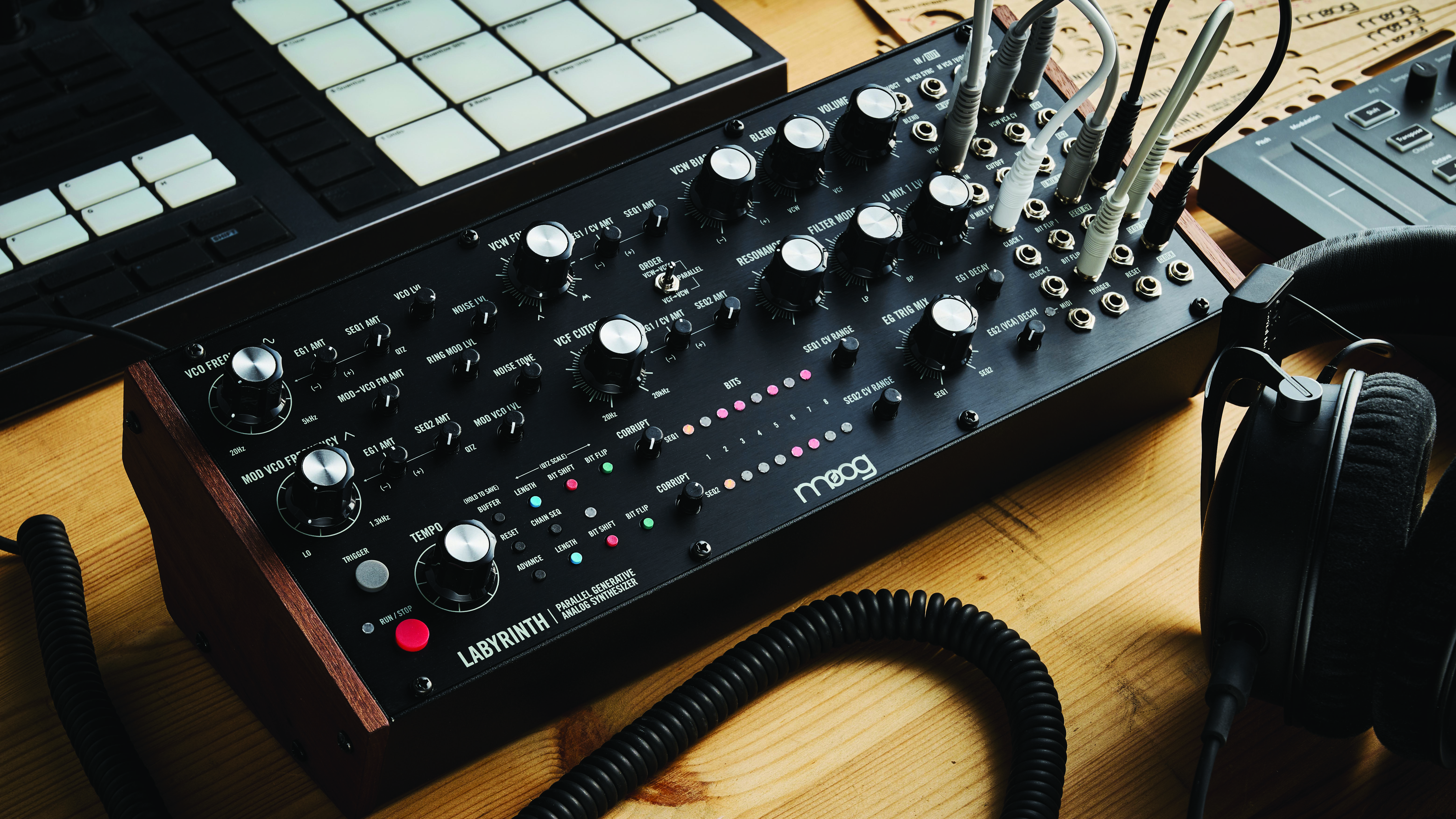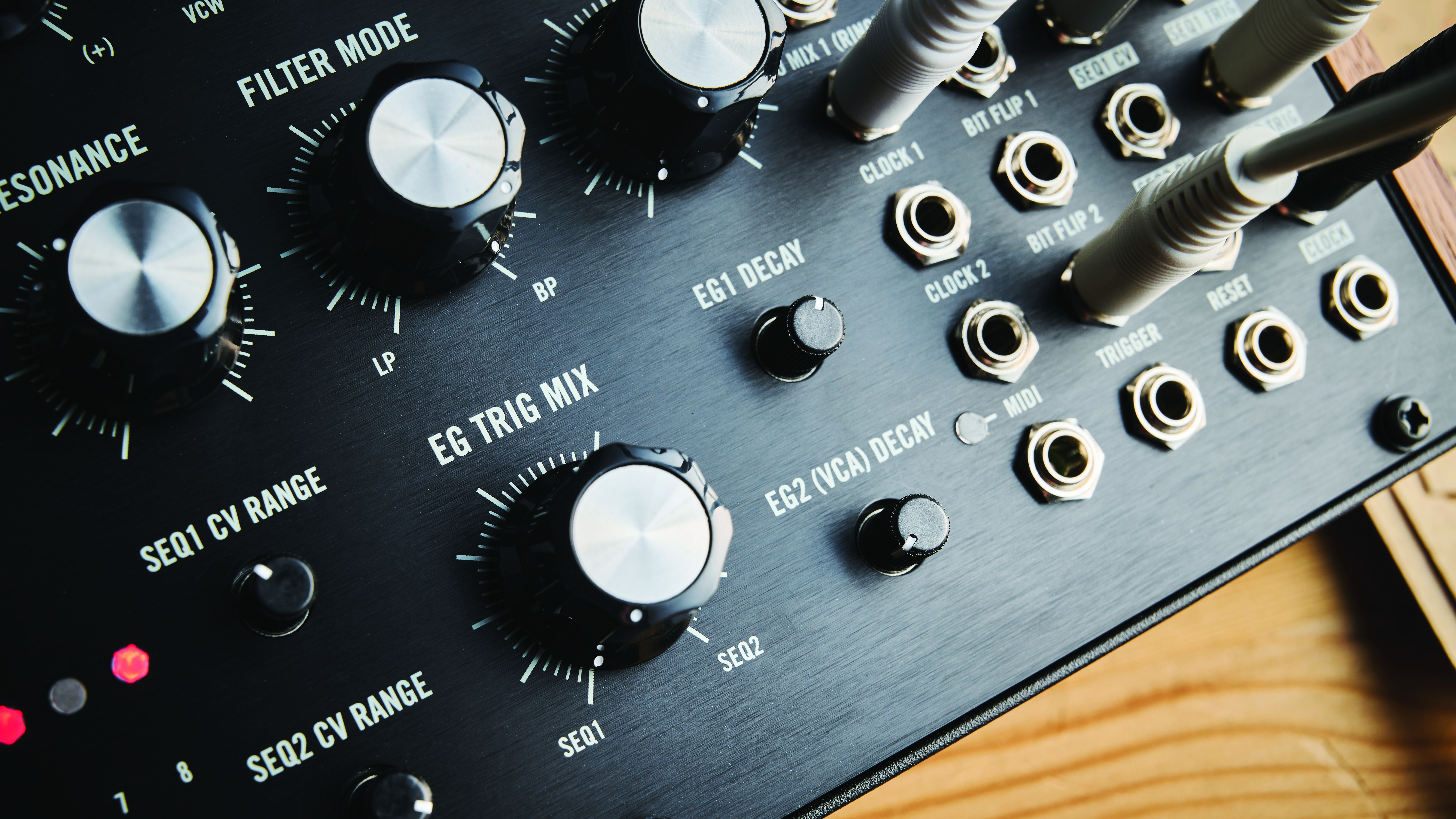
Moog Labyrinth: What is it?
Just a few weeks after its last release, Spectravox, Moog’s latest instrument is another semi-modular addition to the US brand’s range that also includes the Mother-32, DFAM and Subharmonicon.
Moog describes Labyrinth as a ‘parallel generative analogue synth’, a set of words that excites my inner Autechre fan, even if it’s not instantly obvious what they might mean combined. In practice, the first two words refer to two distinctive elements of Labyrinth’s design – its unique dual-path synth engine, and its sequencer, which uses randomisation tools in order to create some unpredictable, polymetric patterns.
Let’s set those generative tools aside for a moment. While they’re undoubtedly an important part of its character, even divorced from these sequencing tools, Labyrinth is a fascinating and capable monosynth in its own right.
If you can look past the fiddly interface, there’s a lot to find inspiring here.
The design here is based around two oscillators. The first is a simple sine wave VCO, while the second is a triangle wave generator labelled as a Mod VCO. The reason for this distinction is that the latter oscillator has an unusually broad operating range, from an audible 1.3kHz at the top end down to slow LFO speeds in its lower ranges. As a result it can function as both a sound and a modulation source.
These oscillators feed into the mixer section in different ways. Each has its own level control, but there’s also a level control for the combined ring modulated output of the two. Further modulation options come from an FM dial, which modulates the frequency of the sine wave osc by the output of the Mod VCO.
Each oscillator can also be modulated by the first of Labyrinth’s two envelopes or by one of the sequencer channels. The mixer itself is designed to be overdriven, resulting in a pleasant analogue saturation that nicely rounds off the harsh upper frequencies of more extreme cross-modulation tones.
The key ‘parallel’ element to Labyrinth’s design lies in what happens after the mixer. Here the sound feeds into two distinct processors – one multimode 2-pole filter, one voltage-controlled wavefolder. A switch dictates if these are arranged in serial or parallel configurations.
By default, the summed mixer output is sent into whichever of these elements is first in the chain, although by making use of the individual inputs and outputs in the patchbay, you can route the oscillators separately for a truly parallel signal path.

The inclusion of the diode-transistor wavefolder adds a nice touch of Buchla-esque, West Coast character to Labyrinth, complementing the audio-rate modulation of the oscillators. This wavefolder creates distortion by folding the incoming waveform back in on itself when driven over a certain threshold.
The VCW Fold control adjusts the level of this effect, which can be modulated using EG1, a CV input or Labyrinth’s sequencer. This is joined by a Bias control, which alters the symmetry of the wavefolding and the harmonics created.
While the 2-pole resonant filter is more straightforward Moog fare, it’s notable for the fact that it can be seamlessly morphed between low- and band-pass configurations. The wavefolder and filter are each given their own voltage-controlled amplifiers, which can be shaped using a shared decay control or individual CV inputs in the patch bay.
The balance of these two outputs is altered using a front panel Blend dial – which also gets a patchbay CV input – allowing users to mix the direct outputs of the wavefolder and filter VCAs whether in parallel or serial configuration.
Backup generator
Labyrinth’s sequencer puts a heavy emphasis on randomisation, albeit in a fairly controllable manner. The sequencer makes use of two lanes – labelled Seq 1 and Seq 2 – that can each be up to eight steps in length. These are primarily designed to be used in parallel, though you can chain the two together to create a single 16-step sequencer.
Rather than contain specific note or parameter information, each sequencer step – referred to here as a ‘Bit’ – is assigned a simple on or off state. When set to on, that step will generate a trigger and a random voltage.
These voltages can have a range between +5 volts and -5 volts, which equates to 10 octaves for Labyrinth’s 1v/oct configuration. This range can be narrowed down, however, using each sequencer’s CV range control. More useful still is the ability to quantise these randomised outputs to one of 16 defined scales.
Further randomisation can be introduced using each sequencer’s Corrupt controls. When set to zero, each sequence will repeat in a predictable, stable manner. Dialling in the Corrupt control up to the 50% mark will introduce changes to the pitches triggered by each Bit. Above 50%, Corrupt begins to alter the rhythm of sequences too, by introducing the possibility that each Bit will flip between off and on with each cycle.
As already alluded to, there are various pre-routed places where these sequenced voltages can be applied to the signal path, including the pitch of each oscillator and the levels of the wavefolder and filter cutoff. The patchbay inputs add further possibilities too.
Particularly interesting is the EG Trig Mix control, which adjusts the level to which each sequencer triggers the synth’s internal envelopes. At either extreme this means that Labyrinth only registers triggers from Seq 1 or Seq 2, while the central position gives equal emphasis to the two.
Any position between these, however, will mean that triggers from one sequencer are registered at a lower velocity than the other, which can be a great tool for introducing an element of variation into sequences, particularly when the two sequencers are set to different lengths or levels of randomisation.
In terms of sound creation tools then, these synth and sequencer elements combine to make one of the most interesting new instruments of recent times. In its self-contained state, the combo of audio-rate modulation, wavefolding and randomisation give Labyrinth a wonderfully experimental feel, making it an ideal gateway into the more esoteric concepts of modular electronic music.
If there’s one criticism I have of its self-contained workflow, it’s that the basic decay-only envelopes necessitate a fairly percussive sound palette, which arguably undersells what the synth engine itself is capable of. This, to be fair, is one area where the semi-modular patchbay pays dividends. The CV inputs for each of the VCAs allow for control via any more complex envelope shapers you have available from external Eurorack gear or another semi-modular synth.
The MIDI input – included on some Moog semi-modulars, but disappointingly absent from others – is another welcome inclusion. This allows for Labyrinth to be played in a more traditional monosynth manner via a keyboard controller or DAW, but also means that the generative sequencers can be synced to an external MIDI clock, enhancing their capabilities as a versatile source of randomisation in the studio.
Moog Labyrinth: Performance and verdict

There’s a lot to like about the overall design of Labyrinth, although I have a few misgivings about the hardware itself. When I reviewed Moog’s Spectravox last issue, I noted that it was the first of Moog’s hardware products to be released since the brand was acquired by InMusic, and since the closure of Moog’s longtime Asheville HQ. While Spectravox notably featured a ‘made in Taiwan’ label on its underside (as does Labyrinth), there was little in the way of an obvious drop in quality compared to previous Moog releases, aside from the lack of a fully printed manual.
It’s unclear if any of these things are a direct result of Moog’s new ownership, but it results in Labyrinth feeling somewhat lower quality than some of its stablemates
This isn’t necessarily the case with Labyrinth, sadly. For one thing, the control surface here makes considerable use of fiddly, uncapped rotaries. These have been a feature of most recent Moog semi-modulars – used for the sequencers of DFAM and Subharmonicon – but they play a more prominent role here, used for adjusting modulation levels, envelope decay and sequencer ranges. The result is an interface that feels unpleasantly fiddly in use.
Worse still are the tiny, loose-feeling buttons used for programming the sequencers, which are both uncomfortable to use and feel like they’re lacking durability. Many deeper sequencer functions rely on awkward, unlabelled combos of button presses. It has to be said too that, at least for our review unit, the Run/Stop button is somewhat unresponsive, often not registering anything other than a firm press.
It’s unclear if any of these things are a direct result of Moog’s new ownership, but it results in Labyrinth feeling somewhat lower quality than some of its stablemates.
To be fair though, none of this detracts too much from the high points of Labyrinth’s design, namely its sound and versatility. While some of Moog’s semi-modular instruments are only likely to appeal in specific contexts or paired with other bits of modular gear, as with Spectravox or Subharmonicon, there’s a lot to recommend Labyrinth, whether it's used as a self-contained desktop synth, as a part of a wider Moog rig or installed as a synth voice-come-sequencer in a Eurorack system.
If you can look past the fiddly interface, there’s a lot to find inspiring here.
MusicRadar verdict: Let down by fiddly rotaries and a cheap-feeling sequencer, but we love its West Coast sound and experimental design







